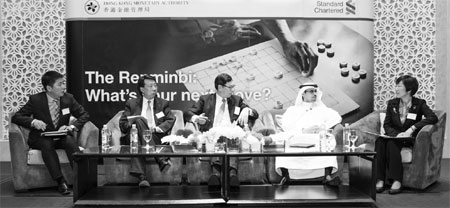Greater yuan currency usage urged for China-Mideast trade
Updated: 2013-01-23 07:09
By Oswald Chan(HK Edition)
|
|||||||
|
Chief Executive of Hong Kong Monetary Authority Norman Chan (center) exchanges views with other speakers at a seminar in Dubai on Monday. GIS Photo |
Greater yuan currency usage in bilateral transactions will provide further impetus for trade and investment links between China and the Middle East resulting in mutual benefits for both sides, Hong Kong Monetary Authority (HKMA) Chief Executive Norman Chan reckoned.
"Trade activities between the United Arab Emirates (UAE) and China have grown more than 10 times over the past decade, from less than $3 billion in 2001 to $37 billion in 2011. China is the UAE's second largest non-oil trading partner and the second largest source of UAE's imports," Chan said.
The city's de facto central bank monetary chief made this remark on Monday at a seminar in Dubai as part of the HKMA's overseas roadshows to promote Hong Kong as the offshore yuan business center.
According to the HKMA, Chinese exports to the Middle East countries jumped $47 billion in 2011 from the $18 billion in 2006; while its imports from the Middle East nations also soared to $87 billion from the $27 billion in 2006.
"As the yuan internationalization progresses, the rapidly expanding offshore yuan market and greater access to the onshore yuan market are also providing new opportunities for the public and private asset managers in the Middle East to diversify and enhance their portfolio investments," Chan added.
According to HKMA data, China has made overseas direct investments of $301 million in UAE in 2011, registering a 10 times surge in the last five years. And China is also diversifying its investments in the UAE's telecoms and construction sectors other than the energy industry. UAE also possess one of the world's largest fiscal reserves - as its sovereign wealth fund is estimated to reach $800 billion.
The central banks of China and UAE are strengthening bilateral financial cooperation. The People's Bank of China and the Central Bank of UAE in January 2012 had signed a bilateral currency swap agreement that allows a currency swap size of 35 billion yuan for a tenor of three years.
Releasing the latest offshore yuan financial business figures in Hong Kong, HKMA said the yuan trade settlement transactions handled by banks in Hong Kong registered some 30 percent growth and exceeded the 2.6 trillion yuan figure in 2012. The Hong Kong Renminbi Real Time Gross Settlement system is handling a growing volume of cross-border and offshore transactions, with average daily turnover amounting to some 260 billion yuan recently compared to only 5 billion yuan in 2010.
Regarding other yuan-denominated financing activities, yuan-denominated dim-sum bond issuance size also grew 60 percent to 230 billion yuan in 2012. Yuan- denominated bank lending soared to 70 billion yuan as at last November compared to a year ago.
Hong Kong possesses the world's largest yuan liquidity pool outside the mainland-as the city's yuan deposits and certificates of deposits totaled 700 billion in 2012, registering a 5 percent growth compared to 2011 and a 10 times surge compared to 2009.
The Hongkong and Shanghai Banking Corporation (HSBC) in Hong Kong, one of the local banks involved in the offshore yuan financial businesses, on Tuesday released its market outlook for offshore yuan business in Hong Kong in 2013.
Regarding trade settlement, HSBC forecasted one-third of China's total merchandise trade will be settled in yuan by 2015 and the yuan currency will replace the British Pound as the third most popular currency for global trade settlement after the US dollar and the euro.
Hong Kong will continue to accumulate its yuan liquidity pool, as the city's yuan deposits will represent 30 percent of the total deposits in the local banking system by 2015 from the current 8.7 percent, according to HSBC.
oswald@chinadailyhk.com
(HK Edition 01/23/2013 page2)
